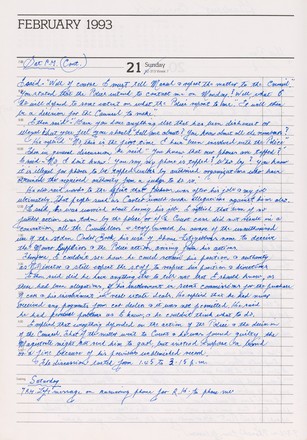Following the 1988 elections, the structures of the Aboriginal
Land Rights Act (ALRA) meant that Aboriginal people were less exposed to the
whims of government and equipped with a ‘war chest’ of sorts to challenge the
government’s agenda. And challenge
they did: in the court of public opinion and the courts.
While the Greiner reforms were unrealised the
changes to the Act that did eventuate radically changed the operations of the
land council and caused bitter division and enmity amongst Aboriginal
people. As Keane’s diary entries
reveal the bitter split between those who agreed with the changes and those
opposed to Greiner’s ‘deal’.
Once
in office the Liberals moved swiftly to implement their Aboriginal Affairs
reforms. Just four weeks into the new Government, in April 1988, the Premier
placed the existing Ministry for Aboriginal Affairs (MAA) under more direct
control of the Premier’s department, with Paul Zammit appointed Parliamentary
Secretary assisting the Premier.
In the first instance, plans to abolish the ALRA were blocked in the
Legislative Council.* The second attempt by the Government to
abolish the ALRA, via the appointment of an administrator to the NSWALC, was
also unsuccessful as there was insufficient legal basis to make an appointment.
The final and ultimately unsuccessful attempt by the Government was to
introduce an amendment to the Regulations of the ALRA that gave the government
power to take control of the assets and finances of the Aboriginal Land Council
network.
The
NSWALC lodged an injunction and proceeded to successfully challenge the
legality of the regulation. Thus,
litigation by NSWALC and lobbying of the cross-parties in the Legislative
Council stymied any immediate Government plans to dismantle the land council
network and control its assets.
But the Government’s influence over the operations of the ALRA
continued. Relocating the Aboriginal
Affairs bureaucracy to the Premier’s department meant that its officers,
including the Registrar of the ALRA and others in relevant departments,
variously pursued the Government’s agenda.
It
was in the Court of public opinion that the ALC and its ever-vigilant members
were most effective. By May 1990,
the Aboriginal Land Council network members had been in a sustained campaign
mode for two years against the Government’s varied efforts to dismantle and
then dramatically reform Aboriginal land rights in NSW. It was in this context that the newly
elected NSWALC Chair, David Clarke, came to approach Keane to work for the
NSWALC in a part-time advisory capacity. The elected Council were aware that the future of land rights
was in grave danger and the grass roots activism strategies that had been
effective in the past needed renewing.
The political negotiations of the elected Aboriginal leadership also
needed to step up a level.
The
campaign developed with the view to impressing the wider Australian public the
benefits of land rights for all
Australians. To this end from July 1990 the elected Councillors embarked on
a two-pronged strategy: an image-raising public relations campaign and a
massive parliamentary petition campaign.
Keane believed that ‘once the State Government realized that the Aboriginal
people were prepared and capable of mounting a campaign that would win public
opinion to their side, they would retreat from their hard line policy ... they
would begin the process of consultation to negotiate amendments which would be
mutually acceptable’.
By
September 1990, the NSW Government entered into negotiations with the Council
Chair David Clarke, to come to a mutually acceptable agreement. At a joint news
conference on 6 September the Premier and NSWALC Chair announced the details of
the agreed amendments to the ALRA Act.
The main change was that the regional tier was abolished and the
election process and tenure of Councillors was altered. They were to be directly elected with
full-time salaried positions instituted. Thirdly, land could be alienated.
While
generally viewed as a ‘back down’ from this more extreme position, the Greiner
amendments that eventuated contained a relatively simple but dramatically
transforming change to the ALRA land dealing provisions. Amongst other changes, they allowed for
land recovered under the Act.
These
changes saw a bitter divide emerge amongst land council members. Characterised
generally as pragmatists on one hand and those concerned with ‘grass roots’
community involvement.
But
the divisions went deeper still and reflect a naivety as well as vulnerability
on the part of elected representatives.
The Greiner changes saw much greater control concentrated in the state
office. At around the same time a
scandal unfolded that revealed corruption on the part of a senior
non-Aboriginal administrator know far and wide across the Aboriginal grapevine
as the ‘lawn mower affair’. In his
diary Keane meticulously documented the revelations by the senior bureaucrat
(subsequently investigated by the NSW Police and ICAC).
* The NSWALC effectively courted the support of the minority parties in the
Council. While the ALP, Greens and
Democrats had long supported the land rights movement, the support of the
right-wing Fred Nile led ‘Christian Democrat Party’ was less assured but one
which was secured by effective lobbying by key church affiliated members of the
Aboriginal community.



 Back to list
Back to list